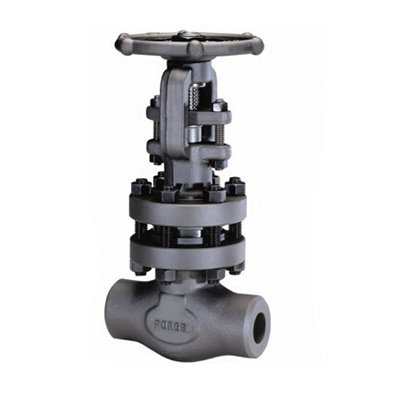Stellite Alloy Surfacing Repair Processes of 15CrMo Forged Gate Valves (Part One)
Stellite Alloy Surfacing Repair Processes of 15CrMo Forged Gate Valves (Part One)
May 07, 2021
 The common damage types of valve seats and mechanisms are introduced based on the structural characteristics of the sealing surface of the gate valve seat. The characteristics of the surfacing material Stellite alloy and the base material 15CrMo and the difficulties in surfacing repair are analyzed. The process of surfacing welding repair is introduced in detail, including preparation before welding, alloy surface surfacing, and surfacing welding surface processing. This process can meet the engineering application.
The common damage types of valve seats and mechanisms are introduced based on the structural characteristics of the sealing surface of the gate valve seat. The characteristics of the surfacing material Stellite alloy and the base material 15CrMo and the difficulties in surfacing repair are analyzed. The process of surfacing welding repair is introduced in detail, including preparation before welding, alloy surface surfacing, and surfacing welding surface processing. This process can meet the engineering application.As opening and closing equipment, gate valves are widely used in petroleum, chemical, natural gas, environmental protection, and other industries. With the innovation of petrochemical, coal chemical and other processes and equipment, the applications of gate valves continue to expand, and the installation position and application conditions are becoming more and more complicated. Operating states of gate valves directly affect the operation and safety of the system. The status of gate valves under severe conditions is very critical in the entire chemical plant, most of which are hard sealed gate valves. In the use process of hard sealed gate valves, their alloy surfaces will inevitably encounter erosion and wear, which will lead to leakage. If you consider replacing the gate valve, the market price of ordinary gate valves is not high, but the prices of large-diameter hard-sealed gate valves and imported hard-sealed gate valves are generally very high. We have to repair the gate valve to improve the economy of operation of equipment.
15CrMo steel is heat-resistant steel with pearlite structure, and its working temperature can reach 550℃, which has high thermal strength, oxidation resistance at high temperature, a certain resistance to hydrogen corrosion, and economical price for materials. Therefore, 15CrMo forged steel gate valves are widely used in the chemical industry.
Hard-sealed gate valves have the advantages of wear resistance and long service life, but it is difficult to repair them after the sealing surface is worn or even damaged. The hardening tendency of the 15CrMo hard-sealed forged steel gate valve is obvious in particular; the weldability is poor, which is limited to site conditions and maintenance cycles of valves. It is difficult to repair the alloy sealing surface during the maintenance cycle.
If the damaged alloy sealing surface is not properly repaired but simply polished before putting it into use. The main risks are: internal leakages of valves, increasing energy consumption of downstream equipment and increasing damage to the valve's sealing surface, resulting in a decline in the entire performance of valves.
Therefore, studying the repair technology of hard-sealed gate valves' sealing surface is of great significance to ensure the performance of hard-sealed gate valves and the economic, normal and safe operation of the device.
1. Causes of damage to the sealing surface of the hard-seal gate valve
The main types of sealing surface damage are slight scratches, short of alloys, and penetrating scratches. The reasons for the damage of the sealing surface can be roughly divided into the following three types.
1.1 Contact friction of the sealing surface
The valve plate is in contact with the valve seat at the sealing position, and their relative movement causes slight scratches on the alloy sealing surface or uniform wear on the whole sealing surface, which is the result of normal use.
1.2 The valve being not closed properly
During the long-term use of the gate valve, the sealing surface will inevitably be partly worn, resulting in leakage and accumulation of medium in the valve cavity. The process medium forms a supersonic fluid in the gap of the sealing surface, which aggravates the damage to the alloy on the sealing surface of the valve seat. The lack of alloy on the sealing surface is generally accompanied by asymmetrical distribution from the center of the shortage to both sides, forming a gradual loss. This situation brings a certain degree of difficulty for repair. The erosion of the sealing surface is caused by improper closing, and the shortage position is generally at the lower edge of the outlet valve seat.
1.3 Jamming of the coke block in the valve internal gap
Coking of internal parts of the valve will cause jamming during valve operation, and penetrating scratches will occur in the opening or closing process of the valve. This kind of valve seat damage is characterized by its depth of wear being greater than normal wear. There is no wear in other positions, except for the scratch part.
According to the degree of damage to the sealing surface, there are roughly the following methods to repair the seat sealing surface: For the valve seat with slight scratches (from 0.1 mm to 0.3 mm) and normal overall wear, the flatness and smoothness of the sealing surface can be restored by grinding; alloy damages such as alloy shortage and penetrating scratches on the valve seat can only be repaired by surfacing alloys.
Next: Stellite Alloy Surfacing Repair Processes of 15CrMo Forged Gate Valves (Part Two)
Previous: Analysis of Tooling for Guide Grooves of Forged Valve Bodies' Wedges
News
About Us
Best Categories
Useful Links